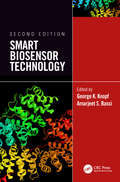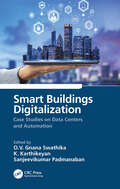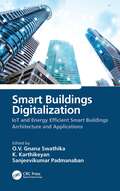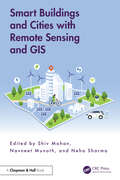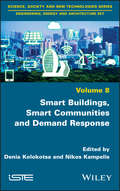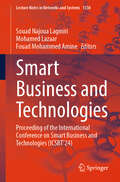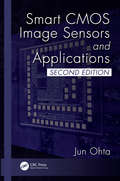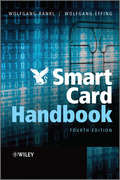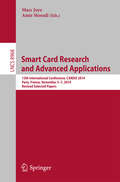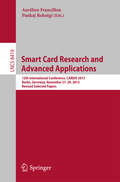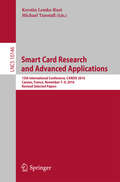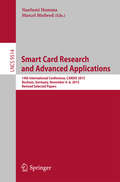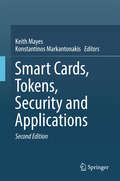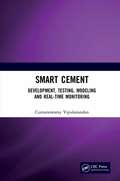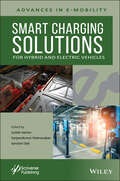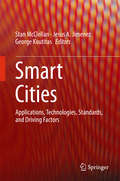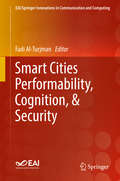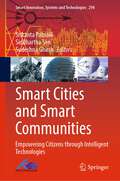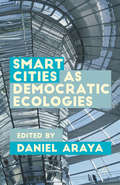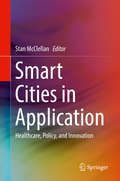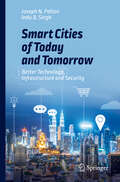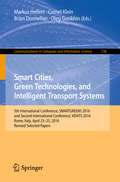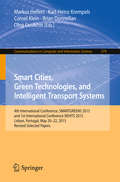- Table View
- List View
Smart Biosensor Technology
by George K. Knopf Amarjeet S. BassiBased on the success of the first edition, this second edition continues to build upon fundamental principles of biosensor design and incorporates recent advances in intelligent materials and novel fabrication techniques for a broad range of real world applications. The book provides a multi-disciplinary focus to capture the ever-expanding field of biosensors. Smart Biosensor Technology, Second Edition includes contributions from leading specialists in a wide variety of fields with a common focus on smart biosensor design. With 21 chapters organized in five parts, this compendium covers the fundamentals of smart biosensor technology, important issues related to material design and selection, principles of biosensor design and fabrication, advances in bioelectronics, and a look at specific applications related to pathogen detection, toxicity monitoring, microfluidics and healthcare. Features Provides a solid background in the underlying principles of biosensor design and breakthrough technologies for creating more intelligent biosensors Focusses on material design and selection including cutting-edge developments in carbon nanotubes, polymer nanowires, and porous silicon Examines machine learning and introduces concepts such as DNA-based molecular computing for smart biosensor function Explores the principles of bioelectronics and nerve cell microelectrode arrays for creating novel transducers and physiological biosensors Devotes several chapters to biosensors developed to detect and monitor a variety of toxins and pathogens Offers expert opinions on the future directions, challenges and opportunities in the field
Smart Buildings Digitalization: Case Studies on Data Centers and Automation
by O.V. Gnana SwathikaThis book explains the concept of data centers, including data collection, public parking systems, smart metering, and sanitizer dispensers. Electric urban transport systems and effective electric distribution in smart cities are discussed as well. The extensive role of power electronics in smart building applications, such as electric vehicles, rooftop terracing, and renewable energy integration, is included. Case studies on automation in smart homes and commercial and official buildings are elaborated. This book describes the complete implication of smart buildings via industrial, commercial, and community platforms. FEATURES Systematically defines energy-efficient buildings employing power consumption optimization techniques with the inclusion of renewable energy sources Covers data centers and cybersecurity with excellent data storage features for smart buildings Includes systematic and detailed strategies for building air-conditioning and lighting Details smart building security propulsion This book is aimed at graduate students, researchers, and professionals in building systems engineering, architectural engineering, and electrical engineering.
Smart Buildings Digitalization: IoT and Energy Efficient Smart Buildings Architecture and Applications
by O.V. Gnana SwathikaThis book discusses various artificial intelligence and machine learning applications concerning smart buildings. It includes how renewable energy sources are integrated into smart buildings using suitable power electronic devices. The deployment of advanced technologies with monitoring, protection, and energy management features is included, along with a case study on automation. Overall, the focus is on architecture and related applications, such as power distribution, microgrids, photovoltaic systems, and renewable energy aspects. The chapters define smart building concepts and their related benefits. FEATURES Discusses various aspects of the role of the Internet of things (IoT) and machine learning in smart buildings Explains pertinent system architecture and focuses on power generation and distribution Covers power-enabling technologies for smart cities Includes photovoltaic system-integrated smart buildings This book is aimed at graduate students, researchers, and professionals in building systems engineering, architectural engineering, and electrical engineering.
Smart Buildings and Cities with Remote Sensing and GIS
by Shiv Mohan, Navneet Munoth, and Neha SharmaThe built environment is undergoing a profound transformation driven by the integration of cutting-edge geospatial technologies. Smart Buildings and Cities with Remote Sensing and GIS serves as a comprehensive guide to navigating this transformation and bridges the gap between traditional architectural and planning practices and the innovative possibilities of remote sensing (RS) and geographic information systems (GIS). The book demonstrates how architects, planners, and decisionmakers can use GIS and RS to design smarter, context-aware, and eco-friendly urban spaces. It explores innovative approaches for architecture, focusing on geospatial site analysis, net-zero energy building designs, heritage preservation, innovative virtual campus planning methodologies and even futuristic concepts like habitat design on the lunar surface. Key features: • Brings together contemporary geospatial technologies and their applications to address the challenges and opportunities in designing smart buildings and cities.• Provides actionable solutions for professionals, researchers, and policymakers.• Includes global contributions that provide diverse perspectives on smart city and building applications.• Highlights how geospatial data-driven insights can revolutionize decisionmaking processes in urban planning and building design.The work is designed for postgraduate students and researchers in the departments of architecture, planning, and geomatics, geoinformatics, software engineering.
Smart Buildings, Smart Communities and Demand Response
by Denia Kolokotsa Nikos KampelisThis book focuses on near-zero energy buildings (NZEBs), smart communities and microgrids. In this context, demand response (DR) is associated with significant environmental and economic benefits when looking at how electricity grids, communities and buildings can operate optimally. In DR, the consumer becomes a prosumer with an important active role in the exchange of energy on an hourly basis. DR is gradually gaining ground with respect to the reduction of peak loads, grid balancing and dealing with the volatility of renewable energy sources (RES). This transition calls for high environmental awareness and new tools or services that will improve the dynamic as well as secure multidirectional exchange of energy and data. Overall, DR is identified as an important field for technological and market innovations aligned with climate change mitigation policies and the transition to sustainable smart grids in the foreseeable future. Smart Buildings, Smart Communities and Demand Response provides an insight into various intrinsic aspects of DR potential, at the building and the community level.
Smart Business and Technologies: Proceeding of the International Conference on Smart Business and Technologies (ICSBT’24) (Lecture Notes in Networks and Systems #1330)
by Mohamed Lazaar Souad Najoua Lagmiri Fouad Mohammed AmineThis book covers the theory, applications, and viewpoints on the most recent and upcoming advancements in the fields of complex processes, decision-making, control, and systems and networks. In the well-known lecture notes in networks and systems series, "Smart Business and Technologies" is the most recent entry. The cutting-edge research presented at the International Conference on Smart Business and technology (ICSBT'24) is compiled in this volume, which highlights creative solutions, new developments, and useful applications in the domains of advanced technology and smart business practices. For scholars, professionals, and students hoping to remain on the cutting edge of business innovation and technology breakthroughs, it is a vital resource. Numerous topics, including cyber-physical systems, artificial intelligence, data analytics, IoT-enabled solutions, autonomous systems, control systems, sustainable business models, digital transformation strategies, blockchain applications, smart supply chain management, customer experience optimization, predictive analytics, energy systems, robotics, smart cities, manufacturing, and more, are covered in the series' proceedings and edited volumes on systems and networks. These subjects provide insights into the methods and paradigms that propel advancement in smart business and technology sectors. They are enmeshed in interdisciplinary fields such as applied sciences, engineering, computer science, business, economics, and social sciences.
Smart CMOS Image Sensors and Applications (Optical Science and Engineering #Vol. 129)
by Jun OhtaBecause of their high noise immunity and low static power supply drain, complementary metal-oxide-semiconductor (CMOS) devices produce less heat than other forms of logic and allow a high density of logic functions on a chip. These beneficial characteristics have fueled the use of CMOS image sensors in consumer electronics, robot vision, biotechnology, and medicine. With the introduction of smart functions in CMOS image sensors, even more versatile applications are now possible.Exploring this popular technology, Smart CMOS Image Sensors and Applications focuses on the smart functions implemented in CMOS image sensors as well as the applications of these sensors. After discussing the history of smart CMOS image sensors, the book describes the fundamental elements of CMOS image sensors. It covers some optoelectronic device physics and introduces typical CMOS image sensor structures, such as an active pixel sensor (APS). Subsequent chapters elucidate the functions and materials of smart CMOS image sensors and present examples of smart imaging. The final chapter explores various applications of smart CMOS image sensors. Several appendices supply a range of information on constants, illuminance, MOSFET characteristics, and optical resolution.This book provides a firm foundation in existing smart CMOS image sensor technology and applications, preparing you for the next phase of smart CMOS image sensors.
Smart CMOS Image Sensors and Applications (Optical Science and Engineering)
by Jun OhtaRevised and expanded for this new edition, Smart CMOS Image Sensors and Applications, Second Edition is the only book available devoted to smart CMOS image sensors and applications. The book describes the fundamentals of CMOS image sensors and optoelectronic device physics, and introduces typical CMOS image sensor structures, such as the active pixel sensor (APS). Also included are the functions and materials of smart CMOS image sensors and present examples of smart imaging. Various applications of smart CMOS image sensors are also discussed. Several appendices supply a range of information on constants, illuminance, MOSFET characteristics, and optical resolution. Expansion of smart materials, smart imaging and applications, including biotechnology and optical wireless communication, are included. Features • Covers the fundamentals and applications including smart materials, smart imaging, and various applications • Includes comprehensive references • Discusses a wide variety of applications of smart CMOS image sensors including biotechnology and optical wireless communication • Revised and expanded to include the state of the art of smart image sensors
Smart Card Handbook
by Wolfgang Rankl Wolfgang EffingThe most comprehensive book on state-of-the-art smart card technology availableUpdated with new international standards and specifications, this essential fourth edition now covers all aspects of smart card in a completely revised structure. Its enlarged coverage now includes smart cards for passports and ID cards, health care cards, smart cards for public transport, and Java Card 3.0.New sub-chapters cover near field communication (NFC), single wire protocol (SWP), and multi megabyte smart cards (microcontroller with NAND-Flash). There are also extensive revisions to chapters on smart card production, the security of smart cards (including coverage of new attacks and protection methods), and contactless card data transmission (ISO/IEC 10536, ISO/IEC 14443, ISO/IEC 15693).This edition also features:additional views to the future development of smart cards, such as USB, MMU, SWP, HCI, Flash memory and their usage; new internet technologies for smart cards; smart card web server, HTTP-Protocol, TCP/IP, SSL/TSL; integration of the new flash-based microcontrollers for smart cards (until now the usual ROM-based microcontrollers), and; a completely revised glossary with explanations of all important smart card subjects (600 glossary terms). Smart Card Handbook is firmly established as the definitive reference to every aspect of smart card technology, proving an invaluable resource for security systems development engineers. Professionals and microchip designers working in the smart card industry will continue to benefit from this essential guide. This book is also ideal for newcomers to the field.The Fraunhofer Smart Card Award was presented to the authors for the Smart Card Handbook, Third Edition in 2008.
Smart Card Research and Advanced Applications
by Amir Moradi Marc JoyeThis book constitutes the thoroughly refereed post-conference proceedings of the 13th International Conference on Smart Card Research and Advanced Applications, CARDIS 2014, held in Paris, France, in November 2014. The 15 revised full papers presented in this book were carefully reviewed and selected from 56 submissions. The papers are organized in topical sections on Java cards; software countermeasures; side-channel analysis; embedded implementations; public-key cryptography and leakage and fault attacks.
Smart Card Research and Advanced Applications
by Aurélien Francillon Pankaj RohatgiThis book constitutes the thoroughly refereed post-conference proceedings of the 12th International Conference on Smart Card Research and Advanced Applications, CARDIS 2013, held in Berlin, Germany, in November 2013. The 17 revised full papers presented in this book were carefully reviewed and selected from 47 submissions. The papers are organized in topical sections on security technologies; attacks on masking; side channel attacks; software and protocol analysis; side channel countermeasures; and side channel and fault attacks.
Smart Card Research and Advanced Applications
by Kerstin Lemke-Rust Michael TunstallThis book constitutes the thoroughly refereed post-conference proceedings of the 15th International Conference on Smart Card Research and Advanced Applications, CARDIS 2016, held in Cannes, France, in November 2016. The 15 revised full papers presented in this book were carefully reviewed and selected from 29 submissions. The focus of the conference was on all aspects of the design, development, deployment, validation, and application of smart cards or smart personal devices.
Smart Card Research and Advanced Applications
by Naofumi Homma Marcel MedwedThis book constitutes the thoroughly refereedpost-conference proceedings of the 14th International Conference on Smart CardResearch and Advanced Applications, CARDIS 2015, held in Bochum, Germany, inNovember 2015. The 17 revised full papers presented in this book werecarefully reviewed and selected from 40 submissions. The focus of theconference was on all aspects of the design, development, deployment,validation, and application of smart cards and secure elements in secureplatforms or systems.
Smart Cards, Tokens, Security and Applications
by Konstantinos Markantonakis Keith MayesProviding a broad overview of the many card systems and solutions in practical use today, this state-of-the art work is written by contributing authors who are active researchers and acknowledged experts in their field. A single book cannot be found to match both the breadth and depth of content. The book combines a cross-discipline overview of smart cards, tokens and related security and applications plus a technical reference to support further research and study. A step-by-step approach educates the reader and by the end of the book the reader should be able to play an educated role in a smart card related project.
Smart Cement: Development, Testing, Modeling and Real-Time Monitoring
by Cumaraswamy VipulanandanOver three billion metric tons of cement are produced annually worldwide, making concrete the most extensively used construction material. Self-sensing, or smart, cement allows real-time monitoring of performance through the entire service life of a concrete structure, for the detection of changing stresses, contamination, excessive temperature, gas leaks and pre-seismic activity. This is achieved by adding a very small proportion of conductive or semi-conductive fibers, such as carbon fibers to the bulk cement, making it piezoresistive, and enabling changes in the concrete’s electrical resistivity in response to shear stress and strain to be monitored. This state-of-the-art reference work presents experimental results with a realistic theoretical framework, for cement manufactures, concrete technologists and contractors as well as researchers.
Smart Charging Solutions for Hybrid and Electric Vehicles
by P. Sanjeevikumar Sulabh Sachan Sanchari DebSMART CHARGING SOLUTIONS The most comprehensive and up-to-date study of smart charging solutions for hybrid and electric vehicles for engineers, scientists, students, and other professionals. As our dependence on fossil fuels continues to wane all over the world, demand for dependable and economically feasible energy sources continues to grow. As environmental regulations become more stringent, energy production is relying more and more heavily on locally available renewable resources. Furthermore, fuel consumption and emissions are facilitating the transition to sustainable transportation. The market for electric vehicles (EVs) has been increasing steadily over the past few years throughout the world. With the increasing popularity of EVs, a competitive market between charging stations (CSS) to attract more EVs is expected. This outstanding new volume is a resource for engineers, researchers, and practitioners interested in getting acquainted with smart charging for electric vehicles technologies. It includes many chapters dealing with the state-of-the-art studies on EV smart charging along with charging infrastructure. Whether for the veteran engineer or student, this is a must-have volume for any library. Smart Charging Solutions for Hybrid and Electric Vehicles: Presents the state of the art of smart charging for hybrid and electric vehicles, from a technological point of view Focuses on optimization and prospective solutions for practical problems Covers the most important recent developmental technologies related to renewable energy, to keep the engineer up to date and well informed Includes economic considerations, such as business models and price structures Covers standards and regulatory frameworks for smart charging solutions
Smart Cities
by Stan Mcclellan Jesus A. Jimenez George KoutitasThis book reviews the applications, technologies, standards, and other issues related to Smart Cities. The book is divided into broad topical sections including Vision & Reality, Technologies & Standards, Transportation Considerations, and Infrastructure & Environment. In these sections, authors who are experts in their fields present essential aspects of applications, technologies, requirements, and best-practices. In all cases, the authors have direct, substantive experience with the subject and present an important viewpoint driven by industry or governmental interests; the authors have each participated in the development and/or deployment of constituent technologies, standards, and applications, and share unique perspectives on key areas of the Smart City.
Smart Cities Performability, Cognition, & Security (EAI/Springer Innovations in Communication and Computing)
by Fadi Al-TurjmanThis book provides knowledge into the intelligence and security areas of smart-city paradigms. It focuses on connected computing devices, mechanical and digital machines, objects, and/or people that are provided with unique identifiers. The authors discuss the ability to transmit data over a wireless network without requiring human-to-human or human-to-computer interaction via secure/intelligent methods. The authors also provide a strong foundation for researchers to advance further in the assessment domain of these topics in the IoT era. The aim of this book is hence to focus on both the design and implementation aspects of the intelligence and security approaches in smart city applications that are enabled and supported by the IoT paradigms. Presents research related to cognitive computing and secured telecommunication paradigms;Discusses development of intelligent outdoor monitoring systems via wireless sensing technologies;With contributions from researchers, scientists, engineers and practitioners in telecommunication and smart cities.
Smart Cities and Smart Communities: Empowering Citizens through Intelligent Technologies (Smart Innovation, Systems and Technologies #294)
by Siddhartha Sen Srikanta Patnaik Sudeshna Ghosh“Smart City” programs and strategies have become one of the most dominant urban agendas for local governments worldwide in the past two decades. The rapid urbanization rate and unprecedented growth of megacities in the 21st century triggered drastic changes in traditional ways of urban policy and planning, leading to an influx of digital technology applications for fast and efficient urban management. With the rising popularity in making our cities “smart”, several domains of urban management, urban infrastructure, and urban quality-of-life have seen increasing dependence on advanced information and communication technologies (ICTs) that optimize and control the day-to-day functioning of urban systems. Smart Cities, essentially, act as digital networks that obtain large-scale real-time data on urban systems, process them, and make decisions on how to manage them efficiently. The book presents 26 chapters, which are organized around five topics: (1) Conceptual framework for smart cities and communities; (2) Technical concepts and models for smart city and communities; (3) Civic engagement and citizen participation; (4) Case studies from the Global North; and (5) Case studies from the Global South.
Smart Cities as Democratic Ecologies
by Daniel ArayaThe concept of the 'smart city' as the confluence of urban planning and technological innovation has become a predominant feature of public policy discourse. Despite its expanding influence, however, there is little consensus on the precise meaning of a 'smart city'. One reason for this ambiguity is that the term means different things to different disciplines. For some, the concept of the 'smart city' refers to advances in sustainability and green technologies. For others, it refers to the deployment of information and communication technologies as next generation infrastructure. This volume focuses on a third strand in this discourse, specifically technology driven changes in democracy and civic engagement. In conjunction with issues related to power grids, transportation networks and urban sustainability, there is a growing need to examine the potential of 'smart cities' as 'democratic ecologies' for citizen empowerment and user-driven innovation. What is the potential of 'smart cities' to become platforms for bottom-up civic engagement in the context of next generation communication, data sharing, and application development? What are the consequences of layering public spaces with computationally mediated technologies? Foucault's notion of the panopticon, a metaphor for a surveillance society, suggests that smart technologies deployed in the design of 'smart cities' should be evaluated in terms of the ways in which they enable, or curtail, new urban literacies and emergent social practices.
Smart Cities in Application: Healthcare, Policy, and Innovation
by Stan McClellanThis book explores categories of applications and driving factors surrounding the Smart City phenomenon. The contributing authors provide perspective on the Smart Cities, covering numerous applications and classes of applications. The book uses a top-down exploration of the driving factors in Smart Cities, by including focal areas including “Smart Healthcare,” “Public Safety & Policy Issues,” and “Science, Technology, & Innovation.” Contributors have direct and substantive experience with important aspects of Smart Cities and discuss issues with technologies & standards, roadblocks to implementation, innovations that create new opportunities, and other factors relevant to emerging Smart City infrastructures.Features an exploration of Smart City issues and solutions from a variety of stakeholders in the evolving fieldPresents conversational, nuanced, and forward thinking perspectives on Smart Cities, their implications, limitations, obstacles, and opportunitiesIncludes contributions from industry insiders who have direct, relevant experience with their respective subjects as well as positioning and corporate stature
Smart Cities of Today and Tomorrow: Better Technology, Infrastructure and Security
by Joseph N. Pelton Indu B. SinghHackers, cyber-criminals, Dark Web users, and techno-terrorists beware! This book should make you think twice about attempting to do your dirty work in the smart cities of tomorrow.Scores of cities around the world have begun planning what are known as “smart cities.” These new or revamped urban areas use the latest technology to make the lives of residents easier and more enjoyable.They will have automated infrastructures such as the Internet of Things, “the Cloud,” automated industrial controls, electronic money, mobile and communication satellite systems, wireless texting and networking. With all of these benefits come new forms of danger, and so these cities will need many safeguards to prevent cyber criminals from wreaking havoc. This book explains the advantages of smart cities and how to design and operate one. Based on the practical experience of the authors in projects in the U.S. and overseas in Dubai, Malaysia, Brazil and India, it tells how such a city is planned and analyzes vital security concerns that must be addressed along the way.Most of us will eventually live in smart cities. What are the advantages and the latest design strategies for such ventures? What are the potential drawbacks? How will they change the lives of everyday citizens? This book offers a preview of our future and how you can help prepare yourself for the changes to come.
Smart Cities to Smart Societies: Moving Beyond Technology (Routledge Studies in Sustainability)
by Elie Azar Imad Antoine Ibrahim Esmat ZaidanThis book explores the governance of smart cities from a holistic approach, arguing that the creation of smart cities must consider the specific circumstances of each country to improve the preservation, revitalisation, liveability, and sustainability of urban areas. The recent push for smart cities is part of an effort to reshape urban development through megaprojects, centralised master planning, and approaches that convey modernism and global affluence. However, moving towards a citywide smart transition is a major undertaking, and complexities are expected to grow exponentially. This book argues that a comprehensive approach is necessary to consider all relevant aspects. The chapters seek to identify the potential and pitfalls of the smart transformation of urban communities and its role in sustainability goals; share state-of-the-art practices concerning technology, policy, and social science dimensions in smart cities and communities; and develop opportunities for cooperation and partnership in wider and larger research and development programmes. Divided into three parts, the first part of the book highlights the significance of various societal elements and factors in facilitating a successful smart transition, with a particular emphasis on the role of human capital. The second part delves into the challenges associated with technology and its integration into smart city initiatives. The final part of the book examines the current state of regulations and policies governing smart cities. The book will be an important asset for students and researchers studying law, engineering, political science, international relations, geopolitics, economics, and engineering.
Smart Cities, Green Technologies, and Intelligent Transport Systems
by Markus Helfert Brian Donnellan Cornel Klein Oleg GusikhinThis book constitutes the thoroughly refereedproceedings of the 4th International Conference on Smart Cities and Green ICTSystems, SMARTGREENS 2015, and the 1st InternationalConference on Vehicle Technology and Intelligent Transport Systems, VEHITS2015, held in Lisbon, Portugal, in May 2015. The 15 full papers of SMARTGREENS 2015 presentedwere carefully reviewed and selected from 73 submissions. VEHITS 2015 received27 paper submissions from which 3 papers were selected and published in thisbook. The papers reflect topics such as smart cities, energy-aware systems andtechnologies, sustainable computing and communications, sustainabletransportation and smart mobility.
Smart Cities, Green Technologies, and Intelligent Transport Systems: 4th International Conference, Smartgreens 2015, And 1st International Conference Vehits 2015, Lisbon, Portugal, May 20-22, 2015, Revised Selected Papers (Communications In Computer And Information Science #579)
by Markus Helfert Karl-Heinz Krempels Brian Donnellan Cornel Klein Oleg GusikhinThis book constitutes the thoroughly refereedproceedings of the 4th International Conference on Smart Cities and Green ICTSystems, SMARTGREENS 2015, and the 1st InternationalConference on Vehicle Technology and Intelligent Transport Systems, VEHITS2015, held in Lisbon, Portugal, in May 2015. The 15 full papers of SMARTGREENS 2015 presentedwere carefully reviewed and selected from 73 submissions. VEHITS 2015 received27 paper submissions from which 3 papers were selected and published in thisbook. The papers reflect topics such as smart cities, energy-aware systems andtechnologies, sustainable computing and communications, sustainabletransportation and smart mobility.
